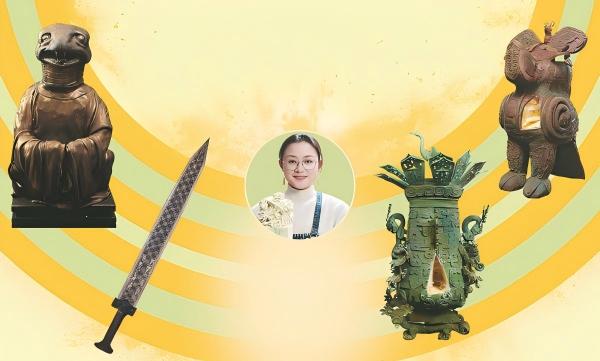Centuries-old relics find new expression through delicate cakes and chocolates, connecting the past with the present in a unique, delicious form.

In the home of 36-year-old Zou Minglei in Wuhan, Hubei province, you'll find some of China's most cherished museum artifacts — not originals, but remarkably lifelike reproductions made of cake and chocolate.
Zou, a talented dessert artist, gained widespread attention earlier this year on the Chinese short video platform Douyin. Her inventive fusion of culinary art and cultural preservation has captivated young Chinese internet users, earning her more than 242,000 likes.
Zou's interest in artifacts took root during her university years when she studied animation and frequently visited museums for artistic inspiration.
"The relics in museums — their patterns, shapes, colors, and craftsmanship — spark endless ideas," she said.
Her journey into transforming these historical treasures into edible art began in 2018. That year, she entered the Cake International competition in the UK and won a silver medal for her fondant cake interpretation of the 2,400-year-old Chime Bells of Marquis Yi of Zeng, a famous set of bronze bells from the Warring States Period (475-221 BC).
At the end of 2024, she set a personal challenge to craft 100 cultural relics in dessert form.
So far, she has completed 17.
In her videos, Zou emphasizes the stories behind each piece rather than simply showcasing her techniques. She recalls visiting the China gallery at the British Museum and noticing that many artifacts had vague descriptions — often limited to just a title and catalog number.
"But every historical treasure has its own unique tale to tell," she said.
ALSO READ: Henan artifacts bring early civilization 'to life'
For example, one of her most popular creations is a cake replica of a bronze owl-shaped zun wine vessel, which has garnered over 100,000 likes. Its adorable appearance stands in stark contrast to the solemn ceremonial role it once played.
The vessel, dating back to the Shang Dynasty (c. 16th century-11th century BC), was unearthed from the tomb of Fu Hao, China's first documented female general and royal consort.
Zou admits the design was complex and she hesitated at first to recreate it. But after learning about Fu's life from a museum guide, she was inspired by the strength of this ancient woman and motivated to take on the challenge.
What touched her most was how Fu Hao's strength still resonates today. "Many women play crucial roles in both their families and careers — they are the heroines of our time," Zou said.
Crafting these artifact-inspired cakes is demanding. One challenge is accurately capturing color.
"Museum lighting and display cases can obscure the true colors of artifacts," she explained. To ensure precision, Zou consults various sources and experiments with edible pigments to mimic the natural aging effects of ancient objects.
She must also consider texture and the original techniques used. To refine details that are difficult to observe in museum settings, Zou turns to an extensive reference book on traditional Chinese motifs, which she calls her "dictionary".
Crafting history
Her choice of materials varies depending on the artifact. While fondant is her usual medium, she used chocolate to replicate the Sword of Goujian, a notable piece from the Spring and Autumn Period (770-476 BC). Chocolate's naturally darker tone closely mirrors the original blade, but its fragility made the process tricky.
Zou researched chocolate's crystal structure and experimented with adding small amounts of glucose or water to make it more pliable for carving.
"Creating these desserts involves a lot of trial and error. Each step requires careful adjustments and thoughtful decisions," she said.
READ MORE: Craftsman keeps alive art of romancing the stone
Zou also strives to highlight the craftsmanship behind the relics. While working on the sword, for example, she discovered that its intricate patterns weren't painted but engraved and filled with tin. To replicate this detail, she used chocolate as the inlay in her reproduction.
"The process feels like having a conversation with artisans from a thousand years ago," she said.
"Through my work, I've gained a deeper appreciation for their perspective and the elegance of traditional Chinese craftsmanship."
Each of Zou's creations typically takes around 20 days to complete, and more complex designs can take over a month. Pieces taller than 50 centimeters need to be scaled down, as larger cakes are difficult to handle.
The production period becomes even more challenging in humid summer weather. Once her sketches are finalized, Zou carefully plans her workflow to ensure each component of the dessert stays fresh throughout the process.
For instance, she recently recreated a black-lacquered drum with bird- and tiger-shaped racks — an artifact from the Warring States Period — during Wuhan's humid rainy season.
"The fondant bird wings alone had to be remade four times due to dampness," she said.
"But the harder it is, the more rewarding it feels when it's done."
These edible masterpieces are eventually shared with family and friends. Though sugar and chocolate can be stored for a long time, ingredients like eggs and cream spoil quickly.
"We usually eat them within two days to avoid waste," she explained.
Looking ahead, Zou is eager to tackle a broader range of artifacts.
ALSO READ: The past is prologue
She is currently working on an openwork porcelain incense burner, aiming not only to replicate its intricate design but also to restore its original function — allowing it to release smoke once again, centuries later, in dessert form.
Her videos have attracted a large online following, including many young parents who watch them with their children.
One mother shared that her daughter, who has a fascination with traditional hair accessories, was inspired by Zou's creations to pursue her interest more seriously.
"Each generation finds its own way to connect with history," Zou reflected. "Young people today use their own language to reinterpret ancient civilizations. They're more curious and passionate about cultural relics than many people realize."


